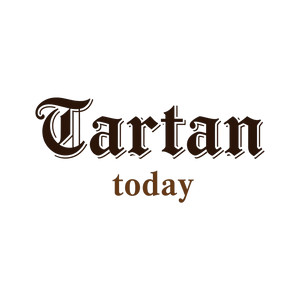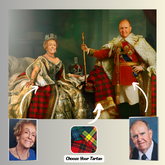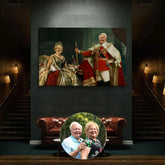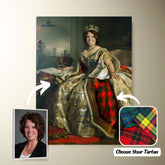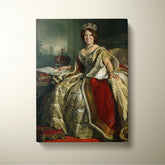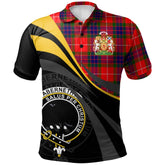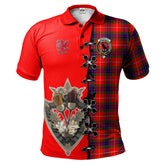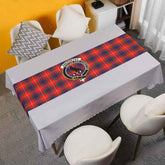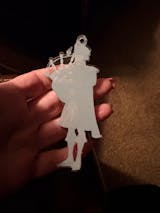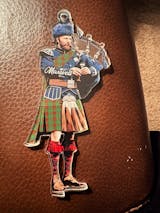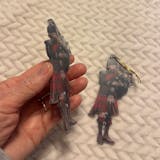-
Clan Abernethy Tartan Crest Keychain KT38 - Abernethy Tartan Clan
Abernethy Tartan Clan Crest Keychain KT38 Product detail: This personalized keychain for pictures are the perfect choice for a fun gift idea, the choice is yours to come up with a surprise for someone you love. The keychain is made of PMMA, environmentally, friendly,...- From $15.25 USD
- From $15.25 USD
- Unit price
- per
-
Abernethy Tartan Clan
-
Personalized Clan Abernethy Ancient Clan Crest Tartan Santa Ornament – Custom Acrylic Christmas Decoration LB28 - Abernethy
Personalized Clan Abernethy Ancient Clan Badge Tartan Ornament – Custom Acrylic Christmas Decoration LB28Celebrate your Scottish heritage with this unique wood & acrylic tartan ornament. Perfect as a personalized Christmas decoration or a meaningful gift for friends and relatives on special occasions such as...- From $19.99 USD
- From $19.99 USD
- Unit price
- per
-
Abernethy
-
Personalized Clan Abernethy Weathered Clan Crest Tartan Santa Ornament – Custom Acrylic Christmas Decoration LN88 - Abernethy
Personalized Clan Abernethy Weathered Clan Badge Tartan Ornament – Custom Acrylic Christmas Decoration LN88Celebrate your Scottish heritage with this unique wood & acrylic tartan ornament. Perfect as a personalized Christmas decoration or a meaningful gift for friends and relatives on special occasions such as...- From $19.99 USD
- From $19.99 USD
- Unit price
- per
-
Abernethy
-
Clan Abernethy Tartan Polo Shirt - Royal Coat Of Arms Style IN12 - Abernethy Tartan
Clan Abernethy Tartan Polo Shirt - Royal Coat Of Arms Style IN12 Description: Crafted in 100% polyester with your own design which combines comfort and vogue. This shirt has some'great features, it has 3 buttons, elastic collar and cuffs. 12.35 Oz. Made from polyester...- $38.25 USD
- $38.25 USD
- Unit price
- per
-
Abernethy Tartan
-
Clan Abernethy Tartan Polo Shirt - Lion Rampant And Celtic Thistle Style BG96 - Abernethy Tartan
Clan Abernethy Tartan Polo Shirt - Lion Rampant And Celtic Thistle Style BG96 Description: Crafted in 100% polyester with your own design which combines comfort and vogue. This shirt has some'great features, it has 3 buttons, elastic collar and cuffs. 12.35 Oz. Made from...- $38.25 USD
- $38.25 USD
- Unit price
- per
-
Abernethy Tartan
-
Clan Abernethy Tartan Polo Shirt - Alba Celtic Style EZ78 - Abernethy Tartan
Clan Abernethy Tartan Polo Shirt - Alba Celtic Style EZ78 Description: Crafted in 100% polyester with your own design which combines comfort and vogue. This shirt has some'great features, it has 3 buttons, elastic collar and cuffs. 12.35 Oz. Made from polyester fabric. 3...- $38.25 USD
- $38.25 USD
- Unit price
- per
-
Abernethy Tartan
-
Clan Abernethy Family Crest Polo T-Shirt KA19
Clan Abernethy Family Crest Polo T-Shirt KA19 Product Detail: KEY FEATURES:- Preshrunk 100% cotton jersey- 6 oz- Welt collar and cuffs- 3 wood tone buttons- Double needle bottom hem CARE INSTRUCTIONS:Machine wash warm, inside out, with like colors. Only non chlorine bleach. Tumble dry...- $38.25 USD
- $38.25 USD
- Unit price
- per
-
Clan Abernethy Clan Unisex Polo Shirt - Celtic Tree Of Life VJ59 - Abernethy Tartan
Clan Abernethy Clan Unisex Polo Shirt - Celtic Tree Of Life VJ59 Description: Crafted in 100% polyester with your own design which combines comfort and vogue. This shirt has some'great features, it has 3 buttons, elastic collar and cuffs. 12.35 Oz. Made from polyester...- $38.25 USD
- $38.25 USD
- Unit price
- per
-
Abernethy Tartan
-
Abernethy Ancient Tartan Clan Crest Badge Aloha Hawaiian Shirt Tropical Old Style II42 - Abernethy Ancient Tartan
Abernethy Ancient Tartan Clan Crest Badge Aloha Hawaiian Shirt Tropical Old Style II42 These Hawaiian shirts and shorts are suitable for hot summer days or beach trips with your friends, family, and loved ones. This is an excellent gift, vacation outfit, or simply revamp...- $43.25 USD
- $43.25 USD
- Unit price
- per
-
Abernethy Ancient Tartan
-
Abernethy Modern Tartan Clan Crest Badge Aloha Hawaiian Shirt Tropical Old Style UD27 - Abernethy Modern Tartan
Abernethy Modern Tartan Clan Crest Badge Aloha Hawaiian Shirt Tropical Old Style UD27 These Hawaiian shirts and shorts are suitable for hot summer days or beach trips with your friends, family, and loved ones. This is an excellent gift, vacation outfit, or simply revamp...- $43.25 USD
- $43.25 USD
- Unit price
- per
-
Abernethy Modern Tartan
-
Abernethy Weathered Tartan Clan Crest Badge Aloha Hawaiian Shirt Tropical Old Style EB17 - Abernethy Weathered Tartan
Abernethy Weathered Tartan Clan Crest Badge Aloha Hawaiian Shirt Tropical Old Style EB17 These Hawaiian shirts and shorts are suitable for hot summer days or beach trips with your friends, family, and loved ones. This is an excellent gift, vacation outfit, or simply revamp...- $43.25 USD
- $43.25 USD
- Unit price
- per
-
Abernethy Weathered Tartan
-
Clan Abernethy Crest Tartan Acrylic Christmas Ornament CJ42 - Abernethy Tartan
Clan Bethune Crest Tartan Acrylic Christmas Ornament FR69“Decorating the house” may be one of the most exciting tasks jotted down on your to-do list when the holiday season approaches. Yet, since shabby, dull-looking pieces of decor infest the marketplace, finding real gems that endure...- From $21.25 USD
- From $21.25 USD
- Unit price
- per
-
Abernethy Tartan
-
Clan Abernethy Tartan Crest Table Runner Cotton NZ76 - Abernethy Tartan
Clan Abernethy Tartan Crest Table Runner Cotton NZ76 Product detail: Made of durable cotton linen cloth material. Lightweight, durable and could be folded away compactly. Multi-function, stylish decor to any room or table. Gentle hand wash separately in cold water; no shrinkle; no color...- $41.15 USD
- $41.15 USD
- Unit price
- per
-
Abernethy Tartan
-
Clan Abernethy Tartan Christmas Ugly Sweater AR42 - Abernethy Tartan
Abernethy Tartan Clan Christmas Ugly Sweater AR42 Product Detail: Each sweater is constructed from a premium woven polyester that is ultra-soft and incredibly comfortable. Features a specialty high definition heat-dye application that ensures long lasting color vibrancy even after machine washing. Fabric is durable...- $48.45 USD
- $48.45 USD
- Unit price
- per
-
Abernethy Tartan
-
Clan Abernethy Tartan Saddle Handbags SA73 - Abernethy Tartan Clan
Abernethy Tartan Clan Saddle Handbags SA73 Product Detail: Manufactured with premium water-proof canvas material. Features a comfortable and sturdy adjustable cross-body carrying strap made with leather and high-quality stitching for long-lasting durability. Finished with multiple interior compartments to keep your items organized.- $55.15 USD
- $55.15 USD
- Unit price
- per
-
Abernethy Tartan Clan
-
Clan Abernethy Tartan Bow Tie MZ72 - Abernethy Tartan Clan
Abernethy Tartan Clan Bow Tie MZ72 Product detail: Unique item with your custom design can be worn on various occasions, such as weddings,'anniversaries, and birthday parties. 100% polyester satin, silky and durable. Adjustable neckband fits neck sizes 11.5' to 20' Flat measurement without knot:...- $34.45 USD
- $34.45 USD
- Unit price
- per
-
Abernethy Tartan Clan
-
Clan Abernethy Tartan Crest Jogger Sweatpants LH93 - Abernethy Tartan
Abernethy Tartan Clan Crest Jogger Sweatpants LH93 Product details: This unisex jogger features a soft and durable fabric. These garments are made from polyester, with each design being made-to-order 95% polyester, 5% spandex Double layer side insert pockets High definition printing colours Design will...- $48.25 USD
- $48.25 USD
- Unit price
- per
-
Abernethy Tartan
-
Clan Abernethy Tartan Unisex Baseball Jersey ZI30WT87 - Abernethy Tartan
Abernethy Tartan Clan Unisex Baseball Jersey ZI30WT87 Product Detail: Each of our baseball jerseys is custom-made-to-order and handcrafted to the highest quality standards. It is not only extremely soft to the touch but breathable as well. Our jersey is printed on sustainable fabrics so...- $42.25 USD
- $42.25 USD
- Unit price
- per
-
Abernethy Tartan
-
Clan Abernathy Tartan Crest Tumbler DE84 - Abernathy Tartan Clan
Abernathy Tartan Clan Crest Tumbler DE84 Product Detail: Abernathy Tartan Crest Tumbler Introducing our Tartan Tumbler, a perfect companion for your daily hydration needs. This mobile tumbler comes with a slide lid and an ideal size, providing convenience as you enjoy your refreshing beverages....- From $45.99 USD
- From $45.99 USD
- Unit price
- per
-
Abernathy Tartan Clan
-
Clan Abernethy Tartan Crest Garden Flag RU76 - Abernethy Tartan Clan
Abernethy Tartan Clan Crest Garden Flag RU76 Product Detail: Welcome guests to your home with this seasonal flag. Available in 2 sizes: Small size 12'x18' and Large size 28'x40' Material: 100% polyester, PU and carbon black. Weatherproof and fade resistant fabric will not fray...- $35.45 USD
- $35.45 USD
- Unit price
- per
-
Abernethy Tartan Clan
Ex: Your Tartan + Product
Popular Products
Turn Me Royal Personalized Portrait from Your Photo, Custom Tartan. Custom Canvas Wall Art as Gift for Men
- From $32.45 USD
- From $32.45 USD
- Unit price
- / per
Royalty Couple Personalized Portrait from Your Photo, Custom Tartan. Custom Canvas Wall Art
- From $47.45 USD
- From $47.45 USD
- Unit price
- / per
The Queen Personalized Portrait from Your Photo, Custom Tartan. Custom Canvas Wall Art as Gift for Women
- From $32.45 USD
- From $32.45 USD
- Unit price
- / per
Which Clan Are You From?
List Of Tartan
-
Clan A
- Abercrombie Tartan
- Aberdeen Tartan
- Abernethy Tartan
- Adair Tartan
- Adam Tartan
- Ayrshire Tartan
- Agnew Tartan
- Aikenhead Tartan
- Ainslie Tartan
- Aiton Tartan
- Allan Tartan
- Alexander Tartan
- Allardice Tartan
- Allison Tartan
- Anderson Tartan
- Angus Tartan
- Anstruther Tartan
- Arbuthnot Tartan
- Armstrong Tartan
- Arnott Tartan
- Auchinleck Tartan
- Ayrshire Tartan
-
Clan B
- Baillie Tartan
- Bain Tartan
- Baird Tartan
- Balfour Tartan
- Bannatyne Tartan
- Bannerman Tartan
- Barclay Tartan
- Baxter Tartan
- Beaton Tartan
- Bell Tartan
- Belshes Tartan
- Bethune Tartan
- Beveridge Tartan
- Binning Tartan
- Bisset Tartan
- Blackadder Tartan
- Blackstock Tartan
- Black Watch Tartan
- Blair Tartan
- Blane Tartan
- Blyth Tartan
- Borthwick Tartan
- Boswell Tartan
- Bowie Tartan
- Boyd Tartan
- Boyle Tartan
- Brisbane Tartan
- Brodie Tartan
- Brown/ Broun Tartan
- Bruce Tartan
- Buccleuch Tartan
- Buchan Tartan
- Buchanan Tartan
- Burnett Tartan
- Burns Tartan
- Butter Tartan
- Byres Tartan
-
Clan C
- Cairns Tartan
- Calder Tartan
- Callander Tartan
- Cameron Tartan
- Campbell Tartan
- Campbell of Breadalbane Tartan
- Campbell of Cawdor Tartan
- Carmichael Tartan
- Carnegie Tartan
- Carruthers Tartan
- Cathcart Tartan
- Chalmers Tartan
- Charteris Tartan
- Chattan Tartan
- Cheyne Tartan
- Chisholm Tartan
- Christie Tartan
- Clark Tartan
- Clelland Tartan
- Clephan Tartan
- Clergy Tartan
- Cochrane Tartan
- Cockburn Tartan
- Colquhoun Tartan
- Colville Tartan
- Cooper Tartan
- Couper Tartan
- Craig Tartan
- Cranstoun Tartan
- Crawford Tartan
- Crichton Tartan
- Crief District Tartan
- Crosbie Tartan
- Cumming Tartan
- Cunningham Tartan
- Currie Tartan
- Clan D
- Clan E
- Clan F
- Clan G
- Clan H
- Clan I
- Clan J
- Clan K
- Clan L
-
Clan M
- Maitland Tartan
- Malcolm Tartan
- Mar Tartan
- Marjoribanks Tartan
- Maxtone Tartan
- Matheson Tartan
- Maule Tartan
- Maxwell Tartan
- Meldrum Tartan
- Melville Tartan
- Menzies Tartan
- Mercer Tartan
- Middleton Tartan
- Moffat Tartan
- Moncrieffe Tartan
- Montgomery Tartan
- Monypenny Tartan
- Moncreiffe Tartan
- Monteith Tartan
- Morrison Tartan
- Mouat Tartan
- Moubray Tartan
- Mow Tartan
- Muir_More Tartan
- Muirhead Tartan
- Munro Tartan
- Murray Tartan
- Murray of Atholl Tartan
-
Clan Mc/Mac
- MacAlister Tartan
- MacArthur Tartan
- MacAlpine Tartan
- MacAulay Tartan
- MacBain Tartan
- MacBean Tartan
- MacBeth Tartan
- MacCallum Tartan
- MacCraig Tartan
- MacColl Tartan
- MacCorquodale Tartan
- MacDiarmid Tartan
- MacDonald Tartan
- MacDonald of Clanranald Tartan
- MacDonald of Sleat Tartan
- MacDonnell of Glengarry Tartan
- MacDonnell of Keppoch Tartan
- MacDougall Tartan
- MacDowall Tartan
- MacDuff Tartan
- MacEwen_MacEwan Tartan
- MacEdward Tartan
- MacFarlane Tartan
- MacGill Tartan
- MacGillivray Tartan
- MacGregor Tartan
- MacGowan (McGowan) Tartan
- MacHardy Tartan
- MacIan Tartan
- MacInnes Tartan
- MacIntyre Tartan
- MacKay Tartan
- MacKillop Tartan
- MacKellar Tartan
- Mackinlay Tartan
- MacKenzie Tartan
- Mackie Tartan
- MacKinnon Tartan
- MacKintosh / MacIntosh Tartan
- MacLeod Tartan
- MacMillan Tartan
- MacNab Tartan
- MacNaughton Tartan
- MacNeil / MacNeill Tartan
- MacNeil of Colonsay Tartan
- MacNicol Tartan
- MacPhail Tartan
- MacPhee_MacFie Tartan
- MacPherson Tartan
- MacQuarrie Tartan
- MacQueen Tartan
- MacRae Tartan
- MacRow Tartan
- MacSporran Tartan
- MacTaggart Tartan
- MacTavish Tartan
- MacThomas Tartan
- McCorquodale Tartan
- McCulloch Tartan
- McFadzen Tartan
- McGeachie Tartan
- McIver Tartan
- McKerrell Tartan
- Clan N
- Clan O
- Clan P
- Clan R
-
Clan S
- Sandilands Tartan
- Scott Tartan
- Scrymgeour Tartan
- Selkirk Tartan
- Sempill Tartan
- Seton Tartan
- Shaw Tartan
- Shepherd Tartan
- Sinclair Tartan
- Skene Tartan
- Skirving Tartan
- Smith Tartan
- Somerville Tartan
- Spalding Tartan
- Spens Tartan
- Spottiswood Tartan
- Stevenson Tartan
- Stewart Tartan
- Stewart of Appin Tartan
- Stirling Tartan
- Strachan Tartan
- Straiton Tartan
- Strange Tartan
- Strathclyde District Tartan
- Stuart of Bute Tartan
- Sutherland Tartan
- Swinton Tartan
- Clan T
- Clan U W Y
- Request Your Clan
Clan Abernethy (Abernethy Tartan)
Obar Neithich, a name in Gaelic
Crest: A raven sable with a gules beak and member.
Salus Per Christum is the company's motto.
There is no Abernethy Tartan, thus they wear Leslie as the origin of the tartan.
Origin of Name: Derived from the Gaelic words for perilous and marshy, respectively, from a town in Strathern, Scotland, near the river Tay. Nith or Nithy is the name of a river in the south of Scotland. Its name may have come from the town of Abernithy, which is located at or close to the river's mouth.
A sable raven with a gules beak and member.
Lands: Perth, Kinross, and Abernethy
Lands of Saltoun: The family owned these lands from the early 1300s until they were sold in 1643. Additionally made Lords Saltoun in 1445, the Abernethys lost the title to the Frasers.
2. Clan Abernethy History
The Strathearn Monastery of Abernethy in Perthshire had an abbot by that name in the 12th century, according to the oldest known instance of the name. Orm de Abernethy, who was also an abbot and saw a charter of William the Lion, was his son.
The East Lothian properties known as Ormison may bear his name. Lawrence was the name of Orm's kid. Lawrence took it upon himself to establish the Baronial House of Abernethy, which endured for more than a century.
A description of these Historical Records of Leslie was published in Edinburgh, 1869, by Colonel Charles Leslie, K.H., 26th Baron of Balquhain.
"Orm, the son of Hugh, held the large lordship of Abernethy, of which the barony of Ballinbreich comprised a part, in the time of Malcolm IV, in 1160, as well as by grants from William the Lion, about 1190. Lawrence, the son of Orm, adopted the surname Abernethy in honor of his holdings.

With the approval of Sir Patrick Abernethy, his son and successor, he gave the Canons of the priory of St. Andrews 10 shillings per year, payable out of Ballinbreich, around 1230. Hugh de Abernethy, the son of Sir Patrick, was a powerful figure both before and during the time of Allexander III, around 1360.
Before September 3, 1296, Sir Hugh de Abernethy was alive because King Edward I of England ordered the sheriff of Forfar to restore Maria, who had been Hugh de Aberneth's heir, to her lands on that day.
His father's replacement was Sir Alexander de Abernethy. Hugh, Sir. He pledged his devotion to Edward on July 1 and again on June 25 of 1296, upholding English interests.
Edward II appointed him warden of the region between the Forth and the mountains in 1310. He was one among the English plenipotentiaries sent to King Robert Bruce in 1312 to negotiate.
On May 3, 1313, Edward II granted him the Wyleighten manor. Margaret, who is married to John Stuart, Earl of Angus, and Mary, who is married to Sir Andrew de Leslie, VI Dominus Ejusdem, were Sir Alexander de Abernethy's daughters and co-heiresses.
In the thirteenth century, Abernethies lived in Upper Lauderdale. John of Abrenethy, a Scottish knight, had safe passage in England in 1399, while George Abrnnete did so in 1465.
Lord Abernethy was one of the three individuals who initially took refuge at the Lesmahagow church in Lanarkshire, where they were given the protection of the church and "the Kings Peace," given by David.
The last Lord of Abernethy whose lineage can currently be confirmed was Sir Andrew. Clan Leslie's initial sept was called Abernethy.
The sixth Lord Leslie's wife, Mary Abernethy, married Andrew. In 1316, the couple was married. With it, Sir Andrew obtained the baronies of Ballinbreich in Fifeshire (the battle cry of Clan Leslie) and Cairney in Forfar (probably now Cairny after Carney became a Leslie Sept). King Robert I the Bruce gave the charters his approval.
The shield that Sir Andrew had quartered the Arms of Abernethy with was thereafter held by the Earls of Rothes. The Earls of Rothes and Ross, the remaining Lords Leslie, and the first Baron of Balquhain are descended from this connection.
Almost all of the Leslie branches in Scotland, Ireland, Germany, Russia, France, and other countries are descended from the last-named, save from the Rothes.
Since every Leslie descended directly from one of those branches carries at least a trace of Abernethy blood, Mary is the ancestress of a sizable portion of the Leslie population.
The Abernethy family persisted and is still among the oldest Scottish families, dating back to the 13th century. Around the world, they scattered.
While many Scots settled on the Continent in the 17th century, it is interesting to note that Aberneys also appeared under the names "Abernetti" and "Ebbernet" in Prussia and Sweden, respectively.
One William Abernathy is supposed to have come in Connecticut somewhere in the first half of the 17th century, becoming the first member of the family to be recorded in the country. Also settling in Ireland was Abernathys.
One of them, John (1680–1740), rose to prominence as a famous and fiercely divisive pastor. After completing his education at the Universities of Glasgow and Edinburgh, John was chosen to serve as the divine in Antrim, Ireland, where he spent the following fourteen years.
The Irish Presbyterian Church split as a result of him becoming involved in internal strife, and the split lasted for a century. John was thought to be a troublemaker.
According to an English historian, his name should be honored by everyone who values individual freedom of thought and expression.
A another John, born in London in 1764, became a well-known surgeon and professor of medicine. His lectures were so well-attended that the hospital to which he was affiliated had to construct an auditorium to accommodate all of his students.
The name can be spelled Abernethy, Abrenethy, Abrnnete, Haberinthan, Abirnythy, Albirnyth, Abernethi, Abernetti, Ebbernet, and Habernethi, among other variations.
3. Clan Abernethy Tartans
Abernethy can don either the Fraser or Leslie tartan because it is a sept of both Clans Fraser and Leslie.
3.1 Clan Fraser Tartans
3.2 Clan Leslie Tartans
4. Clan Abernethy Crest & Coats of Arms
4.1 Clan Abernethy Crest
4.2 Clan Abernethy Coats of Arms
Note on Coats of Arms: A coat of arms is given to an individual under Scottish heraldic law (with the exception of civic or corporate arms). A 'family coat of arms' does not exist. With the exclusions listed above, the weapons depicted below are personal weapons. The only person authorized to use these weapons is the grantee.


Arms for Jean de Abernethy
5. Clan Abernethy Places & People
5.1 Abernethy Places
5.1.1 Hawthornden Castle

The Abernethy family was the area's first known occupant, according to Hawthornden Castle. Nearby Roslin (Midlothian) is about a mile away, and it is located on the north bank of the River North Esk.
5.1.2 Abernethy

A village in Perth and Kinross, Scotland, called Abernethy (Scottish Gaelic: Obar Neithich) located around 8 miles from Perth.The place name derives from the Picts and means "mouth of the river Nethy."
The settlement was formerly the "capital" (or at least a significant religious and political hub) of the Pictish kingdom.
5.2 Abernethy People
A Scottish baron descended from lay Abernethy abbots, Alexander de Abernethy lived from around 1271 until 1315.
In 1291, Alexander made an allegiance oath to Edward I. Between 1301 and 1303, he served Scotland as a warden. Abernethy was demoted in King Edward's 1305 regulations, yet he backed Balliol over Robert the Bruce. He fought alongside John of Brittany to protect Galloway from Robert Bruce.
He held a number of additional warden of Scotland roles between the Forth and Orkney and between the Forth and the highlands beginning in 1308. Additionally, he had a contract to serve under Sir John de Segrave's command in Perthshire and Berwick.
Around 1311, he was the keeper of Dundee, and in 1312, he led the town's vain defense against Edward Bruce. Alexander left for England in 1314 after Abernethy was forfeited and joined to the earldom of Angus, and he passed away at the end of 1315.
An English surgeon named John Abernethy lived from April 3, 1764, to April 20, 1831. He is most known today for having given his name to the Abernethy biscuit—a coarse-meal baked product intended to help with digestion.

7. Clan Abernethy: Tracing the Ancient Lineage
The Abernethy Clan holds a deep-rooted history that can be traced back to the Pictish clans of ancient Scotland. With origins in Abernethy, a place in southeastern Perthshire, the name Abernethy carries profound significance.
It is derived from the Pictish language and translates to "mouth of the river Nethy" [1]. This surname has merged with the rich traditions and cultural tapestry of Scotland, becoming intertwined with the identity of the land.
In this comprehensive article, we will delve into the history of the Abernethy family, explore their contributions to various fields and countries, and highlight their immigration to the United States.
Join us on this journey through time as we unravel the captivating story of Clan Abernethy.
8. The Origins of Abernethy: A Place Rooted in History
A. The Meaning Behind Abernethy
The name Abernethy holds deep historical significance as it derived from a place called Abernethy in southeastern Perthshire.
Abernethy is a parish that draws its name from the Gaelic term "Aber," meaning "termination," and "Nethy," referring to the river near the entrance of Spey [1]. The deep connection to the land and its rivers shapes the identity of the Abernethy Clan.
B. Tracing the Pictish Ancestry
The Abernethy Clan can be traced back to the Pictish clans of ancient Scotland. The Picts were a confederation of tribes who inhabited the eastern and northern parts of Scotland during the Late Iron Age and Early Medieval periods.
They left a lasting mark on the Scottish landscape and their influence can still be felt within the Abernethy lineage.
C. The Culdee Monastery and Native Origins
In the 12th century, the Abernethy family can be traced as lay abbots of the Culdee Monastery of Abernethy in Strathearn.
This historical connection suggests that they descended from the original native stock of Scotland, separate from Saxon or Norman origins. Hugh, the first known Abernethy, was believed to have lived until the mid-12th century.
His son, Orm, succeeded him as lay abbot and appeared as a witness to charters by prominent figures such as Emulphus or Arnold, the bishop of St. Andrews, and William the Lion.
Orm was the first member of the family to bear the territorial appellation "de Abernethy." Some speculations suggest that Orm may have given his name to the lands of Ormiston in East Lothian, an estate neighboring Salton [2].
Although Orm was a common name at the time, the association with Abernethy is significant.
D. Grant of the Church of Abernethy
Between 1189 and 1196, King William the Lion granted the church of Abernethy to the Abbey of Arbroath.
This grant solidified the clan's connection to the land and the church, and Lawrence, the son of Orm de Abirnythy, transferred his rights in the advowson of the church of Abernethy to the church and monks of Arbroath.
Lawrence remained the Lord of Abernethy, retaining his land and position within the community [2]. This exchange further solidified the Abernethy family's ties to Abernethy as they continued to play an integral role within the parish.
9. The Abernethy Family: Contributions and Variations in Name
A. The Evolving Name: Abernethy Variations
Throughout history, the Abernethy surname has undergone variations in spelling. These variations include Abernathy, Abernathie, and Abernettie.
The changes in spelling reflect the shifting linguistic landscape over time, as dialects and pronunciations influenced the written form of the name.
It is important to consider these variations when researching the Abernethy family history, as they offer additional avenues for exploration.
B. Notable Figures: Contributions to Different Countries
The Abernethy Clan has produced remarkable individuals who have made significant contributions in various fields and countries.
One such figure is John Abernethy, a renowned surgeon born in London in 1764. Despite being born in London, John Abernethy was celebrated for his Irish and Scottish heritage, connecting him to the Abernethy lineage.
His contributions to the field of surgery left a lasting impact, making him an important part of the family's legacy.
C. Global Influence: Abernethys Around the World
The reach of the Abernethy Clan extends far beyond Scotland. Notable individuals with the Abernethy surname have made their mark in countries such as Scotland, Australia, and the United States.
Especially in the United States, the surname Abernethy has garnered relative popularity, highlighting the migration of family members in search of better opportunities and freedom.
10. The Abernethy Diaspora: Finding a New Home in the United States
A. Scots Seeking New Horizons
The immigration and settling of Abernethy family members in the United States represent a significant chapter in the clan's history.
Like many other Scots, they left their homeland in search of greater freedom and opportunities.
The pull of the New World enticed Abernethys to venture across the Atlantic, ultimately reshaping their lives and leaving a lasting impact on American shores.
B. United Empire Loyalists and the American War of Independence
During the American War of Independence, some Abernethys chose to remain loyal to the British Crown and became United Empire Loyalists.
Their allegiance to Britain shaped their fate as they resettled in Canada and other British territories, further diversifying the Abernethy diaspora.
C. Nurturing Heritage: Clan Societies and Highland Games
In recent times, the emergence of clan societies and highland games has played a crucial role in reconnecting Scots, including Abernethys, with their national identity and heritage.
These events serve as platforms to celebrate Scottish culture, fostering a sense of belonging for those who carry the Abernethy name.
11. Conclusion
As we conclude our journey through the centuries, we are left with a deep appreciation for the rich history and heritage of Clan Abernethy.
Through tracing their roots back to the Pictish clans of ancient Scotland, understanding the significance of their ancestral lands, and exploring the contributions made by Abernethys across different fields and countries, we grasp the vast tapestry of their legacy.
The Abernethy family's migration to the United States and their continued influence on the global stage further exemplify the enduring impact of their name.
Today, the Abernethy surname remains relatively popular, serving as a testament to the clan's enduring presence. Let us cherish this intricate tale and honor the profound connections that bind us to our ancestors.
- Choosing a selection results in a full page refresh.
